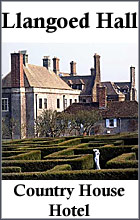Rhos means 'moor' or 'moorland' in Welsh. It is a region of the Denbigh Moors (or Mynydd Hiraethog), formerly a cantref of Denbighshire in north Wales.
Kingdom: history and archaeology
Rhos is identified as a small kingdom during the sub-Roman and early medieval periods in an Old Welsh genealogical document �Ancestry of the Kings and Princes of Wales� listing thirteen of its kings (including two who are known to have ruled the wider region of Gwynedd).
The most famous monarch was perhaps Cynlas Goch, the son of Owain Ddanwyn, who lived in the early 6th century and was denounced by the monk, Gildas. He wrote (in Latin) that Cynlas was the �guider of the chariot which is the receptacle of the bear�. The latter object may refer to a �Fort of the Bear�, possibly Dinerth, the name of a hillfort on Bryn Euryn in Llandrillo-yn-Rhos. The road that runs below the western side of the hill is still called Dinerth Road and Dinarth Hall is nearby.
The Gwynedd Archaeological Trust have undertaken a trial excavation of this hillfort and set up related information boards in Colwyn Bay Library. Their investigations revealed a massive defensive stone wall, well built and faced with good-quality limestone blocks originally rising to about ten feet high. The ramparts were eleven and a half feet thick. These defences are unlike those of Iron Age hillforts but comparable with similar Dark Age fortifications, so may represent a possible palace of the Kings of Rhos.
Administrative unit
By the 11th century, Rhos had become split off from the district of Gwynedd Is-Conwy to form one of the Welsh administrative units known as a cantref. Along with its three adjoining cantrefi, the area was known as Y Berfeddwlad or the 'Middle Country' lying between Gwynedd and Powys and often changing hands between those two powerful early kingdoms. With the loss of Welsh independence in 1283, Rhos became part of the lordship of Denbigh, as granted to the English Earl of Lincoln. The cantrefi were abolished in 1536, but the name of Rhos survives today in places such as Llandrillo-yn-Rhos, Llanelian-yn-Rhos, Penmaen Rhos and Rhos-on-Sea. | 


